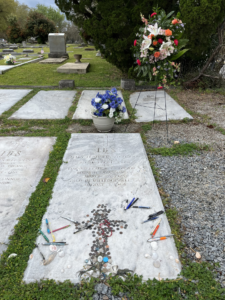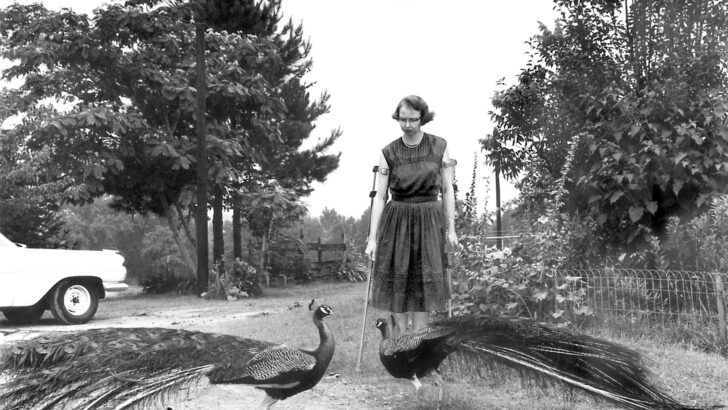This year marks the 100th birthday of the legendary Catholic writer Flannery O’Connor. Her hometown of Milledgeville, Georgia, drew admirers from all over to take part in the festivities, which included a cake and a ‘Dress Like Flannery’ contest. Writers from all over came to her grave to place their pens, described Fr Damian Ference, Vicar for Evangelisation for the Diocese of Cleveland and author of Understanding the Hillbilly Thomist. He said he celebrated Mass at her home parish, Sacred Heart, in a conversation we had discussing O’Connor’s enduring significance—both as an artist and in the realm of evangelisation. As the Church navigates this era of secularisation, he emphasised that her work is as vital as ever. Her centennial birthday provides an opportunity to reflect on how her life and work serve as a model for women, the faithful, and artists alike.
Evangelisation
Fr Ference noted that Gen-Z is the first generation where more young women are leaving the Church than men—a concerning trend. He sees Flannery O’Connor as the perfect counterpoint to this decline. She exemplifies intellectual rigor, unwavering faith, and artistic excellence. She wrestled with how to be both a great artist and a faithful Catholic without compromising either. A Prayer Journal provides a glimpse into her struggles with faith, doubt, ambition, and suffering, demonstrating a deep interior life shaped by her relationship with God.
Many young women, Fr Ference explained, remain spiritual but have become distrustful in the institutional Church which comes from a whole range of scandals and failings. O’Connor herself was not blind to the warts of a church made up by fallen people, yet she never wavered in her fidelity. Instead, she saw it as her responsibility to make it better. To this end, Fr Ference points to her as a prime model for evangelisation, not through conventional preaching but through her radical commitment, her deep and vibrant faith, and her storytelling.
If her stories put people off at first, it is because they demand a willingness to engage with suffering and the human condition in its rawest form”
For some readers, O’Connor’s fiction can shock or even repulse. A friend of mine once recommended her work to someone who later returned saying they hated it. Fr Ference offered some crucial insights into understanding her work. Primarily, her stories are not meant to be comfortable but transformative. Her work confronts readers with grace, sin, redemption, often through grotesque and violent means.
If her stories put people off at first, it is because they demand a willingness to engage with suffering and the human condition in its rawest form. Fr Ference gave three key indicators that one is beginning to understand O’Connor.
- You laugh. Her stories contain dark humour, and recognising the absurdity in them signals a deeper engagement.
- You see yourself in a despised character. Just as Christ’s parables reveal uncomfortable truths, O’Connor’s characters hold up a mirror to the reader.
- You leave the story more human than before. If her work deepens your self-awareness, your relationship with God, or your compassion for others, then you are reading her well.
Realities
O’Connor’s stories often conclude with shocking violence, a method she employed to awaken her readers to spiritual realities. As she says, “I have found that violence is strangely capable of returning my characters to reality and preparing them to accept their moment of grace. Their heads are so hard that almost nothing else will do the work.”
She rejected sentimentality and intellectualism in favour of hard truths. Like Simone Weil, she understood affliction—not as something to be avoided, but as a means of purification, drawing the soul toward God.
Though for her, it is never violence for it’s own sake. Rather it is there to showcase the intensity and seriousness of the faith. Fr Ference also highlighted how O’Connor’s writing aligns with the apophatic tradition, revealing where God is not in order to emphasise where He is. As she famously wrote, “To the hard of hearing you shout, and for the almost-blind you draw large and startling figures.”
For Flannery O’Connor, writing was a discipline akin to prayer. She considered it a vocation, and she believed that a true vocation involves limitation—a paradox only an artist can fully understand. “Vocation implies limitation, but few people realise it who don’t actually practice an art.”
The question then remains: what does this mean for human suffering, where things are not so quickly remedied?”
O’Connor maintained that a Catholic writer’s primary duty is to create great art; faith naturally infuses the work when the artist is serious about their faith. As she put it, “Not every Catholic novelist needs to be a Catholic, but they do need to be a novelist.”
When asked about how Flannery O’Connor can help us in this Jubilee year of Hope, Fr Ference made it clear quoting from Spes non confundit, the declaration of the year of hope, that hope is linked with patience, a virtue which is lost in a world of instant communication, next day deliveries. The question then remains: what does this mean for human suffering, where things are not so quickly remedied?
For Flannery O’Connor, hope is not mere optimism but endurance. She understood that grace is often violent, that redemption is costly, and that the world’s brokenness can lead to transformation. She suffered from lupus for 14 years, lived in relative isolation, and faced criticism for her work from those who didn’t understand it – yet she never abandoned her faith nor her writing. Hers is a hope which comes through the Cross from the Resurrection.
Flannery O’Connor is not an easy writer, but she is a necessary one. As Fr Ference highlights, reading her teaches us not only to be better readers but to be more human. As we celebrate her centennial, her legacy calls us to deeper faith, deeper art, and deeper engagement with the world around us.




 Flannery O'Connor is seen in this 1962 photo. From March 21-23, 2025, a museum in Savannah, Ga., dedicated to her literary genius and fascinating personality is celebrating the centennial of her birth with socials, specialty tours, author talks and a live band, culminating in an annual birthday party event that will include vendors, games and an O'Connor look-alike contest. (OSV News photo/AP Photo, Atlanta Journal-Constitution, Joe McTyre via PBS)
Flannery O'Connor is seen in this 1962 photo. From March 21-23, 2025, a museum in Savannah, Ga., dedicated to her literary genius and fascinating personality is celebrating the centennial of her birth with socials, specialty tours, author talks and a live band, culminating in an annual birthday party event that will include vendors, games and an O'Connor look-alike contest. (OSV News photo/AP Photo, Atlanta Journal-Constitution, Joe McTyre via PBS) 